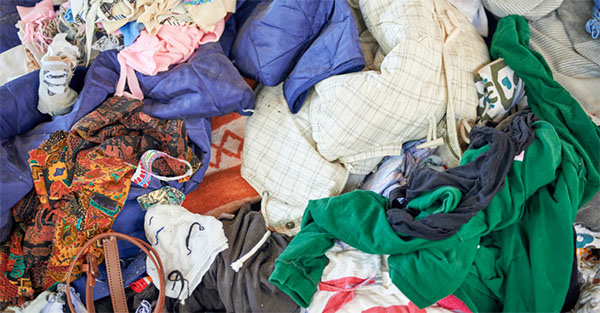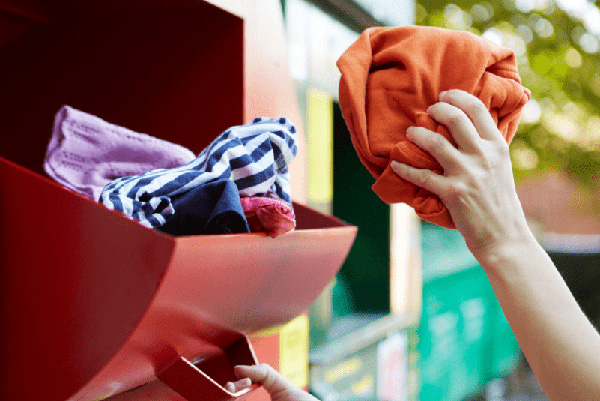We’re buying more clothes than ever before. According to the BBC, the average consumer buys 60% more clothing now than they did 15 years ago. With the rise of fast and affordable fashion, more and more of us are treating ourselves to new outfits.
But all of this clothing costs more than the price tag. In the UK, more than two metric tons of clothing are bought every minute – Oxfam estimates that this produces almost 50 metric tons of carbon emissions. In the USA, 85% of all textiles thrown away end up in landfill. And globally, it’s estimated that 92 million metric tons of textile waste are created every year. That’s the equivalent of a garbage truck full of clothes going to landfill every second.
Reusing and recycling clothing is one way that we can reduce textile waste and help the environment. Clothing banks are an easy and convenient way to recycle used clothing and textiles by transforming waste into a resource. And teaming textile bins with smart waste technology can help organizations make an even bigger impact in the recycling arena.
This article dives into the top 5 benefits of powering clothing banks with smart waste sensors.
Smart Waste Sensors and Clothing Banks
Smart waste sensors are small devices powered by IoT that fit inside clothing banks. They monitor various data points inside bins, including fill levels and movement. All of this data is sent to an online platform via the cloud. After logging onto the platform, logistics and operations managers can remotely monitor the fill levels of clothing banks. These data points are converted into actionable insights that managers can use to optimize collection services.
Clothing banks are dedicated bins for textile recycling. They are often managed by charity organizations, who resell, reuse, and recycle clothing and textiles. They turn your old and unwanted clothing into a new resource for someone else to enjoy. And they use the funds raised to finance non-profit projects.
Find Out More About How Smart Waste Sensors Work.

“Donated clothing is an essential revenue stream for Goodwill and funds our community projects. But our clothing banks were often overflowing and collected too late. This caused serious inventory issues and lost donations. But the Nordsense solution has completely changed this. This data-driven approach to our logistics has helped us optimize our collection services and increase operational efficiency.”
– Kassia Lilly, Vice President of Operations for Goodwill Industries of Kanawha Valley, Inc.
1. Tackle Irregular Waste Cycles
Today’s waste cycles are unpredictable. As we shift towards more online working and shopping, our waste generation patterns have become unreliable. This means that you can no longer rely on historic trends or fixed waste collection services.
This is particularly true for textile waste. The amount of textile material and clothing that people donate varies. Sometimes clothing banks fill up very quickly within just a few days. But sometimes, the containers remain almost empty for weeks. This makes it difficult for waste operations managers to know when they should run collection services.
Real-time data on the fill levels of clothing banks can help operations managers tackle unpredictable waste patterns. Data from smart waste sensors enables managers to monitor the fill levels of clothing banks on their computer. Then, they can schedule collection services exactly when they are needed. This means that they can implement dynamic collection services. And they can focus on emptying full clothing banks and avoid unnecessary collection services to half-empty bins.
2. Eliminate Unnecessary Collection Services
Today, many clothing bank organizations risk driving large routes to service empty containers. These early collection services could be skipped. But instead, it results in high running costs with more drivers working and more vehicles on the road.
Data from smart waste sensors provides logistics managers with an overview of clothing banks. This enables them to adjust collection routes, so that empty banks are skipped. Not only will organizations experience significant cost savings, but it also has a positive environmental impact, as the amount of fuel consumed by pickup vehicles is reduced.
3. Reduce Overflowing Clothing Banks
Overflowing clothing banks pose several problems. Firstly, when clothing containers are full, people tend to leave their donations on the ground beside the bin. This often renders the donated textiles unusable. And it makes it impossible for others to donate and recycle their clothing.
However, overflowing clothing banks are also a hygiene and aesthetics issue. In general, organizations find it difficult to receive permission from municipalities to place their clothing banks in city center areas. Central placements are regarded as highly convenient for textile recycling – and can be a contributing factor to increasing textile recycling rates. But unfortunately, many people find the clothing banks unattractive. And even more so when they are overflowing with textile waste and bags of clothes strewn around them.
Smart waste sensors mean that operations managers never have to run the risk of full or overflowing bins. They can schedule collection services before it’s too late thanks to digital waste insights. In San Francisco, smart sensors have been extremely effective at reducing overflowing waste. Here, they have cut down the number of overflowing bins by 80%. With results like these, unsatisfied locals and municipal officials may be positively persuaded about new locations and placements of clothing banks powered by smart waste sensors.

4. Cut Down on Contaminated Clothing
When clothing banks are full, people leave their donations beside the bin. People may think that these donations can simply be picked up on the next collection round, but that is sadly not the case. Left out in poor weather conditions, the textile recycling often becomes spoiled and unusable.
Sometimes, these donations are put inside the clothing bank by a friendly passerby. Unfortunately, this actually does more harm than good. It contaminates the contents of the entire bin, rendering all of the textiles unusable.
Operations managers for clothing banks can say goodbye to contaminated clothing banks and look forward to collecting even more clothing by using smart waste sensors. The Danish Salvation Army estimates that smart waste sensors will enable them to receive 20-25% more clothing. That corresponds to USD 300,000-750,000 in extra funds for charitable work.
5. Optimize Your Waste Operations
Convenience is key when it comes to increasing recycling rates. And data from smart waste sensors can help you by providing more transparency of your waste operations. More data and transparency enable you to optimize recycling initiatives and make textile recycling easier for residents.
Fill level data on clothing containers provides insights into the areas of the city that require more textile recycling points. By tracking how quickly clothing banks fill up, you can prioritize resources, install more bins in busy areas, or reassess the placement of existing clothing banks.
Turn Textile Waste into a Resource with Smart Waste Sensors and Clothing Banks
A data-driven approach to managing clothing banks can help you increase recycling rates, eliminate overflowing bins, and run more cost- and carbon-efficient collection services. It is difficult to predict how frequently clothing containers are used, which makes smart waste sensors an ideal match for this type of waste. Instead of checking every single clothing bank in town, operations managers are empowered to monitor fill levels remotely and schedule collection services when they are needed.
Learn More About Smart Waste Sensors and Clothing Banks.
